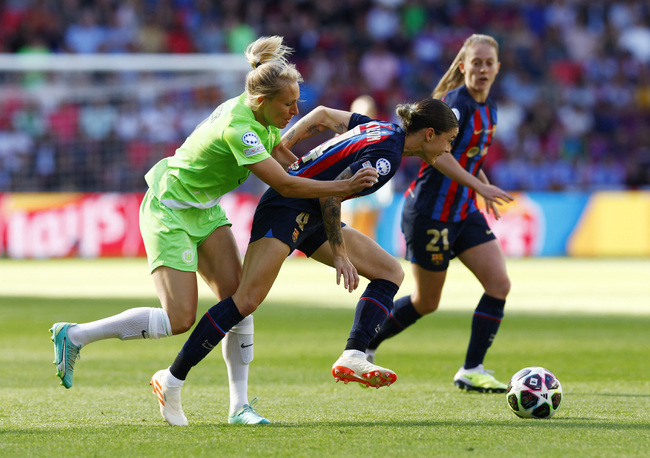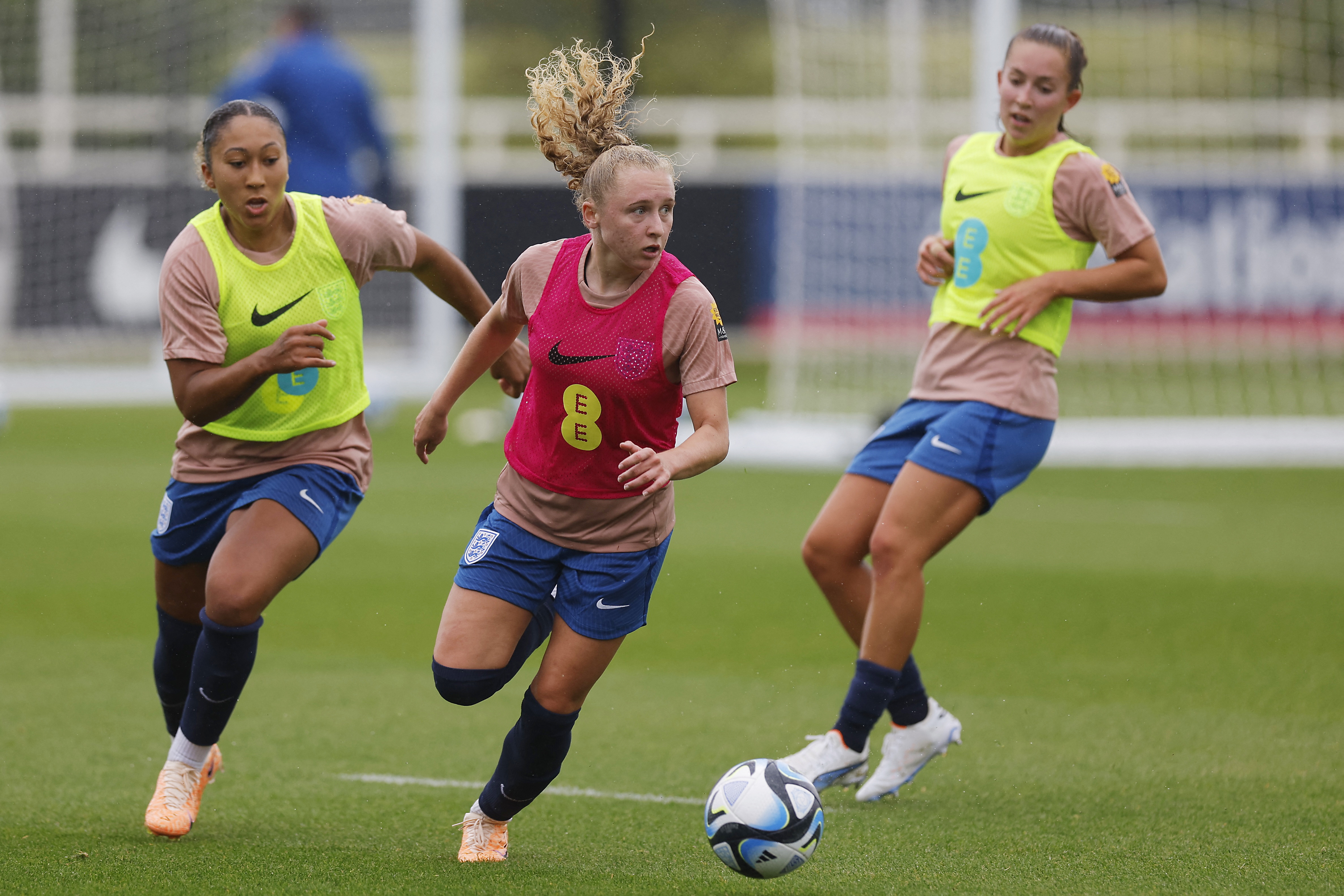You are viewing 1 of your 1 free articles
Kicking for Health: The Lifelong Benefits of Football
From the playground to the golden years, Marianke van der Merwe uncovers how football enhances the health of female athletes.
FC Barcelona’s Mapi Leon in action with VfL Wolfsburg’s Pauline Bremer REUTERS/Piroschka Van De Wouw
More than 26 million women participate in football worldwide, and it is one of the world’s fastest-growing female sports from a recreational to professional level(1). Taking part in football has great health benefits and is a fun recreational activity for untrained women. However, menopause is detrimental to health as many women reduce their physical activity levels, which may increase their risk of developing various health conditions(2). Football offers many benefits as a training modality for premenopausal and postmenopausal women and as a treatment for type II diabetes mellitus and osteoporosis.
Premenopausal untrained women
Researchers in Denmark examined the intermittent exercise performance and cardiovascular health profile of elite female football players compared to untrained young women(1). The physiological adaptations obtained from training two hours a week for 16 weeks in untrained women show significant benefits for skeletal, muscular, and cardiorespiratory function (see table 1)(1,2).
Table 1: Physiological adaptations in untrained women after 16 weeks of recreational football training(1,2).
| Physiological factor | Untrained women |
| Anthropometry |
Decrease in total fat mass. Increase in lean mass. |
| Cardiac structure | Increased left ventricular (LV) posterior wall thickness. Increased right ventricular (RV) diameter. Increased LV and RV end-diastolic diameters. |
| Cardiac function | Increased end LV diastolic volume. Improved LV systolic and diastolic performance. Improved RV systolic function. |
| E/A ratio (Ratio of early to late diastolic filling velocities of the left ventricle) | Significantly improved to similar elite-level values. |
| TAPSE (Tricuspid Annular Plane Systolic Excursion) | Enhanced RV function. |
| Resting heart rate | Decreased. |
| Arterial blood pressure | Decreased diastolic and systolic blood pressure. |
| Maximal oxygen uptake (VO2max) | Increased relative to body weight by 16%. |
| Blood lipid levels | Decreased triglyceride levels. |
| Intermittent exercise performance | Average improvement of 320m in the Yo-Yo Intermittent Endurance level 2 test. |
The researchers found no between-group differences in cardiac function(1). Moreover, more recently, another group of researchers found that 16 months of recreational football training significantly improved myocardial chamber dimensions and LV and RV performance, accompanied by marked increases in mechanical muscle function, rapid force capacity, and postural balance ability(2). Furthermore, acute football training imposed substantial adaptive stress on skeletal muscle (increase in plasma cytokine), bone (increase in osteocalcin), and tendon (increase in procollagen type 1 amino-terminal propeptide)(2).
Premenopausal elite football women
As mentioned, the health benefits are not limited to untrained athletes. Elite players also show increased cardiac dimensions, LV diastolic function, and cavity size(1,2). VO2 max is a strong predictor of cardiovascular risk, with the elite players having a 40% higher VO2 max than the untrained women(1). The Danish researchers showed that despite elite athletes having low blood pressure values before the 16-week training, small changes were evident in diastolic and systolic blood pressure(1). These changes might be due to increased striated muscle capillarization, reduced systematic vascular resistance, and decreased arterial stiffness(1,2).
Postmenopausal untrained women
Women become more physically inactive and have a higher risk for cardiovascular diseases, type II diabetes, and decreased skeletal and muscle health during menopause(2). Estrogen is a vital hormone that protects women against cardiovascular disease, but levels decrease with menopause and cause women to have higher mortality than men(2). Reduced estrogen also leads to annual decreases of 1.9% in bone mineral density (BMD) and 1.3% in bone mineral content (BMC)(3). However, positively, two days of one hour each for 16 weeks of recreational football training leads to a 7-12% increase in VO2 max(2,3). Postmenopausal women older than 60 have a higher concentration of circulating TNF-α, indicating chronic pro-inflammatory circulating cytokines(2). Infiltration of fat into skeletal muscle reduces the contractile component of the total muscle volume, decreasing the whole muscle’s intrinsic strength(2).
When performing isometric and isokinetic voluntary contractions, older untrained women have a higher level of serum IL-6 concentration than younger women(2). An inverse relationship exists between voluntary muscle activation and basal IL-6 levels, which strongly suggests that adipocyte-derived IL-6 negatively affects voluntary skeletal muscle activation. However, 12 weeks of moderate-intensity aerobic training in postmenopausal women with metabolic syndrome reduces the pro-inflammatory interleukins(2). Small-sided football training can reduce the inflammation markers in postmenopausal women, being an effective treatment against chronic inflammation(2). This type of training improves skeletal muscle mass and the skeletal muscle’s oxidative capacity(2). Furthermore, small-sided games used in training can impose the optimal stimulus for the rate of force development adaptation and acceleration capacity(2).
Beating chronic disease
Type II diabetes mellitus
If impaired glycaemic control is left untreated, it can lead to type II diabetes mellitus (T2DM)(4). Prediabetes is characterized by impaired glucose tolerance, fasting glycemia, or both(4). Individuals with diabetes show LV dysfunction (diabetic cardiomyopathy) even though they do not have coronary artery diseases or hypertension, which is associated with increased myocardial lipid content(2). Implementing a 12-week home-based high-intensity interval training (HIIT) program significantly improves LV systolic and diastolic function and thus can be used as a treatment for diabetic cardiomyopathy(2).
In pre-and postmenopausal women with T2DM, HIIT programs improve blood glucose control and metabolic health(2). Football having the nature of high-intensity and resistance training, is a suitable training method for this population. To improve insulin sensitivity in 48–68-year-old T2DM individuals, three 40-minute sessions a week for 12 weeks accompanied by the right dietary improves metabolic health(2,4). Not only does dietary advice and football training improve blood glucose regulation, but it also increases VO2 max, reduces triglycerides and blood cholesterol, and dramatically improves the muscles’ oxidative capacity(2).
Hypertension
Fifteen weeks of recreational football training significantly reduces the total cholesterol and triglyceride levels and decreases the mean arterial pressure in premenopausal women with hypertension(2). Moreover, small-sided game training also increases lean body mass by 7% and reduces total body mass(2). The researchers also found that other hypertensive factors, such as fat mass, resting heart rate, and total plasma cholesterol improved due to the training(2).
Bone mineral density and bone mineral content
The decrease in estrogen with the onset of menopause has detrimental effects on a women’s bone health. When comparing elite and untrained footballers, the elite group portrayed a 13% higher total BMD, a 23% higher BMC, and a 45% higher resting plasma osteocalcin showing how vital exercise is for bone health(2). Football training positively affects BMD and bone turnover markers (BTM) in premenopausal women, demonstrating the positive osteogenic impact of participation in weight-bearing sports(2). High-intensity forces are needed to create positive osteogenic changes, so combining field and resistance training optimizes outcomes(2). To prevent falls in the older population, practitioners should pay attention to the postural balance of these individuals. A 16-week football training period leads to a 29% reduction in fall probability in youth athletes, showing positive outcomes for balance(3).
"Football Fitness" for women
Football has the power to create meaningful positive health benefits. However, practitioners need to be purposeful when creating women-specific sessions. The adaption of a men’s training program is inadequate as female physiology differs significantly. Coaches and practitioners should aim to meet the demands of the sport and the competition level. Recreational football offers a low-barrier-to-entry sport with broad biopsychosocial benefits, and elite sports require a different approach. As a brief overview for recreational athletes, programs should consist of one-hour training sessions broken down into an injury prevention warm-up of 10-15 minutes followed by small-sided drills and pair-based technical exercises for 20-25 minutes and end with a 20-30 minute small-sided drill of 4v4, 5v5 or 6v6 with two goals and one ball and rule adjustments(2). This program was invented for women and girls to develop their football skills. It also provides a social and motivational environment where women of all ages, skill levels, and physical fitness capabilities can join.
Conclusion
Recreational football training effectively induces positive adaptations in skeletal muscle function and mass, neuromuscular function, sprint, and acceleration capacity and decreases the risk of osteoporosis due to constant bone loading(2). Managing the negative effects of menopause remains a challenge in clinical practice, but perhaps football offers an opportunity to create meaningful change. A simple sport loved worldwide can beat the detrimental health effects of aging in women, and sports medicine professionals are ideally placed to advocate for increased resources and better training methodology in women’s football.
References
1. J of Sports Sci, 2013, Vol. 31, No13, 1421-1431
2. Euro J of Applied Physiology (2018) 118:11-32
3. Euro J of Applied Physiology (2021) 121:2825-2836
4. Euro J of Applied Physiology (2019) 119:2011-2024
Newsletter Sign Up
Subscriber Testimonials
Dr. Alexandra Fandetti-Robin, Back & Body Chiropractic
Elspeth Cowell MSCh DpodM SRCh HCPC reg
William Hunter, Nuffield Health
Newsletter Sign Up
Coaches Testimonials
Dr. Alexandra Fandetti-Robin, Back & Body Chiropractic
Elspeth Cowell MSCh DpodM SRCh HCPC reg
William Hunter, Nuffield Health
Be at the leading edge of sports injury management
Our international team of qualified experts (see above) spend hours poring over scores of technical journals and medical papers that even the most interested professionals don't have time to read.
For 17 years, we've helped hard-working physiotherapists and sports professionals like you, overwhelmed by the vast amount of new research, bring science to their treatment. Sports Injury Bulletin is the ideal resource for practitioners too busy to cull through all the monthly journals to find meaningful and applicable studies.
*includes 3 coaching manuals
Get Inspired
All the latest techniques and approaches
Sports Injury Bulletin brings together a worldwide panel of experts – including physiotherapists, doctors, researchers and sports scientists. Together we deliver everything you need to help your clients avoid – or recover as quickly as possible from – injuries.
We strip away the scientific jargon and deliver you easy-to-follow training exercises, nutrition tips, psychological strategies and recovery programmes and exercises in plain English.











